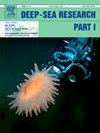Modeling mesoscale circulation and potential fish larvae transport at the entrance of a semi-enclosed sea under different periods
IF 2.1
3区 地球科学
Q2 OCEANOGRAPHY
Deep-Sea Research Part I-Oceanographic Research Papers
Pub Date : 2025-02-01
DOI:10.1016/j.dsr.2024.104430
引用次数: 0
Abstract
Data from three oceanographic cruises at the entrance to the Gulf of California (April 2012, June 2015, and October 2020) were used to model the transport of preflexion fish larvae associated with the mesoscale eddies that dominated the surface circulation during the study periods. Hydrographic transects crossed sections of various eddies of different life histories (origin, rotation, dimensions). A lagrangian particle tracking model (HYCOM) was applied to a cross-Gulf transect using six key locations over the mesoscale structures. The 14-day simulations showed that most particles were retained within the eddies. In April 2012, 85% of the particles remained at the entrance to the Gulf of California until day 7, and one week later, 34% arrived at the north side of the boundary between the entrance to the Gulf of California and the southern Gulf (with no free transport to north). In October 2022, no particles arrived at the southern Gulf of California during the 14 days. In June 2015, however, >90% of the particles were transported to the north by day 14, and 56% of these, to the southern Gulf of California, corresponding with the detection of the poleward Mexican Coastal Current on the mainland side. Dominant fish species in the region with seasonal changes in abundance included Benthosema panamense (mesopelagic), Auxis spp. (epipelagic), Bregmaceros bathymater (pelagic neritic) and Syacium ovale (soft-demersal). Extrapolating the modeling results to preflexion fish larvae distributions, it appears that these mesoscale structures may trap most of the larvae spawned in the Gulf of California entrance. June 2015 was the exception when the fish larvae could disperse from the entrance to the Gulf of California towards the north, corresponding with the period of spawning for some soft-demersal fish species in the region. We conclude that the high mesoscale activity that occurs most of the year at the entrance to the Gulf of California might be a dynamic barrier that controls the dispersal of fish larvae and other planktonic organisms in the region, and might occur in other semi-enclosed seas as well.

不同时期半封闭海入口中尺度环流和潜在鱼苗输送的模拟
利用2012年4月、2015年6月和2020年10月在加利福尼亚湾入口处进行的三次海洋巡航的数据,模拟了在研究期间与主导地表环流的中尺度涡旋相关的预挠曲鱼幼鱼的运输。水文横断面是不同生活史(起源、旋转、尺寸)的各种漩涡的横截面。采用拉格朗日粒子跟踪模型(HYCOM)对中尺度结构上六个关键位置的跨墨西哥湾样带进行了研究。为期14天的模拟表明,大多数粒子被保留在涡流中。2012年4月,85%的粒子在加利福尼亚湾入口处停留到第7天,一周后,34%的粒子到达加利福尼亚湾入口处和南海湾边界的北侧(没有自由向北移动)。在2022年10月的14天里,没有粒子到达加利福尼亚湾南部。然而,在2015年6月,90%的颗粒在第14天被向北输送,其中56%的颗粒被输送到加利福尼亚湾南部,这与大陆侧探测到的墨西哥海岸流的两极方向相对应。丰度随季节变化的优势鱼类有中远洋Benthosema panamense、上远洋Auxis spp、中远洋浅海Bregmaceros bathymater和软底栖Syacium ovale。将模拟结果外推到预弯曲鱼类的幼虫分布,这些中尺度结构可能会捕获在加利福尼亚湾入口产卵的大部分幼虫。2015年6月是一个例外,当时鱼类幼虫可以从加利福尼亚湾的入口向北扩散,与该地区一些软底栖鱼类的产卵期相对应。我们的结论是,加利福尼亚湾入口一年中大部分时间发生的高中尺度活动可能是控制鱼类幼虫和其他浮游生物在该地区扩散的动态屏障,并且可能也发生在其他半封闭海域。
本文章由计算机程序翻译,如有差异,请以英文原文为准。
求助全文
约1分钟内获得全文
求助全文
来源期刊
CiteScore
4.60
自引率
4.20%
发文量
144
审稿时长
18.3 weeks
期刊介绍:
Deep-Sea Research Part I: Oceanographic Research Papers is devoted to the publication of the results of original scientific research, including theoretical work of evident oceanographic applicability; and the solution of instrumental or methodological problems with evidence of successful use. The journal is distinguished by its interdisciplinary nature and its breadth, covering the geological, physical, chemical and biological aspects of the ocean and its boundaries with the sea floor and the atmosphere. In addition to regular "Research Papers" and "Instruments and Methods" papers, briefer communications may be published as "Notes". Supplemental matter, such as extensive data tables or graphs and multimedia content, may be published as electronic appendices.

 求助内容:
求助内容: 应助结果提醒方式:
应助结果提醒方式:


